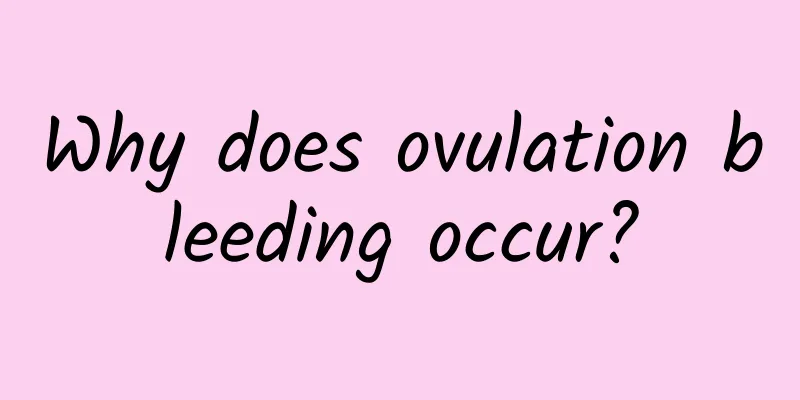Why does ovulation bleeding occur?

|
Why does ovulation bleeding occur? Many couples who are actively trying to have a baby will make good use of the ovulation period, but ovulation bleeding makes them very worried. They worry about what is wrong with their bodies, the quality of the fertilized egg, and the normal development of the fetus. So, why does ovulation bleeding occur? Many female friends may experience ovulation bleeding. Generally, the amount of bleeding is very small, and many people don't even notice it at all. However, some people will have obvious bleeding symptoms, and the severity cannot be generalized. Ovulation bleeding has both physiological reasons and reproductive system diseases, such as irregular menstruation, cervical polyps, cervical erosion, cervical cancer, endometrial adenocarcinoma, uterine submucosal fibroids, endometrial polyps, etc. Experts say that patients with physiological ovulation bleeding do not need to worry too much, they just need to pay attention to it in their daily lives, such as paying attention to menstrual hygiene, eating less spicy food, and not overworking. Usually, before ovulation, the estrogen level of women reaches its peak. When ovulation occurs, the mature follicle ruptures, the egg is released, and the estrogen level drops rapidly, causing the endometrium, which is nourished by estrogen and undergoes a hyperplastic reaction, to lose support and cause a little bleeding. Under normal circumstances, this bleeding is extremely short (about 1 to 2 hours), and only red blood cells can be seen in the leucorrhea under a microscope. The duration of visible vaginal bleeding can be a few hours, or 3 to 5 days, but rarely more than 7 days. In severe cases, it can also be continuous until the next menstrual period. Generally speaking, ovulation bleeding will last for 2-3 days, which is something that every woman may experience, so don't worry. If it is clean within 2-3 days, there is no problem, but if the leucorrhea is accompanied by blood for more than 7 days, and the amount of bleeding is large, then it needs to be taken seriously and timely treatment is required if necessary. |
<<: What are the characteristics of intrauterine adhesions?
>>: What are the harmful manifestations of intrauterine adhesions?
Recommend
What are the complications of abortion?
In recent years, more and more people have had ab...
What are the adverse reactions of medical abortion?
Medical abortion, also known as drug abortion, ha...
What should you pay attention to in your diet for pelvic inflammatory disease? Supplement protein in time
Pelvic inflammatory disease is mainly a skin dise...
Experts introduce the diagnostic basis of primary dysmenorrhea
Clinically, dysmenorrhea is divided into primary ...
The E. coli group in Shagua Oolong Green Tea exceeds the standard by 15 times
Although the weather is starting to get cooler, m...
What are the early symptoms of miscarriage? There are these 3 major symptoms
You should pay attention to all aspects of your b...
What are the hazards of cervical erosion
Once cervical erosion occurs, the amount of leuco...
Four common advantages of painless abortion
Nowadays, many female friends will choose painles...
What are the common symptoms of uterine fibroids? Can uterine fibroids cause uterine bleeding?
What are the symptoms of uterine fibroids? This n...
Experts teach you how to diagnose dysmenorrhea
Do you know how to diagnose dysmenorrhea? Dysmeno...
To address the problem of school children eating out, the Children's Alliance launched "Healthy Eating 135"
The Children's Welfare Alliance Cultural and ...
Principles to be followed in treating menopause
For every woman, the transition from adolescence ...
Are female cervical warts serious?
I believe that many people know about genital war...
Where to treat cervical warts
Sitting and waiting for death is not an option fo...
Will irregular menstruation prevent pregnancy?
Irregular menstruation may affect fertility becau...









